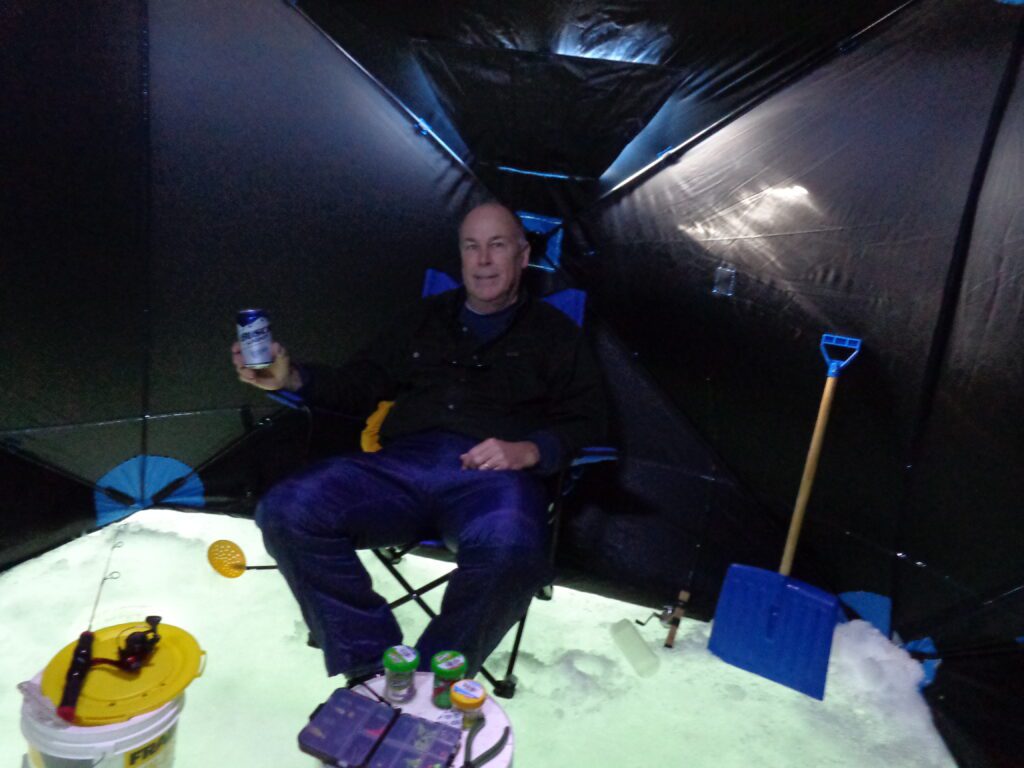Necessary Gear for Ice Fishing
As I prepare for my ultimate and full entry into the world of ice fishing, I have decided that — although I’m sure many get by with less; obviously more is always possible. There are definitely several items of equipment that I consider to be essential. At the very least, these include proper clothing, a portable shelter, ice auger, ice skimmer, small heater and a five-gallon pail.
If you want to be comfortable, the number one consideration is a good pair of waterproof and very warm boots, followed by layers of lightweight, warm clothing. Cold feet will lead to a miserable day on the ice!
As for a shelter, there are several manufacturers (Otter, Frabill, Eskimo, Clam and Shappell) that make shelters ranging in size from single-man up to a two/three-man that can be connected to form something akin to a duplex on the ice. Your consideration must include the fact that you are going to be towing this thing from your car to your spot on the ice. If you have an ATV, perhaps you aren’t worried about weight.
But you also need to consider that if your shelter is too light and the day turns windy, your shelter can quickly become something like a kite… unless you have some ice anchors that will securely fasten your shelter to the ice! Weight can range from as little as twenty pounds to over a hundred. You may end up purchasing some ice spikes for your boots to make walking easier, and also fashioning some sort of sled from an old pair of snow skis to make travel less of a task.

Ice Fishing Shelter Types
Some of these shelters are referred to as “pop-up”, pop-over” or “flip-over”. They are pretty slick and easy to set up. Drill a hole, pop your shelter over you and start fishing! Some have seats as part of the structure, and some do not. If the seat is not part of the shelter, you will obviously need to think about what you want to sit on.
Some are equipped with a floor as part of the structure; some are not. Those without floors make for easier logistics when it comes to drilling holes. These are all things to consider before purchasing a shelter. Depending on manufacturer, style and size, cost will vary widely and can range from as little as $100 to as much as $600 or more.
Drilling through the ice is a task — literally — that requires a special instrument. Augers can be of the manual type, which will run about $75. Or they can be motorized, in either gas or electric versions. Be prepared to pay upwards of $400 for this gadget, whether gas or electric. I still have a bit of homework to do here, but my chiropractor actually made my decision for me when he asked how many holes I would want to drill on a given day — before I need to call for an appointment — if the ice were more than six inches thick… The auger shown in the photo is a Nils Hand Ice Auger.
My choice will be a motorized version! And based on the newer battery technologies, I am leaning toward an electric auger. By the way, bit size is also something to be considered, especially when the fish coming through that hole may not quite fit if the hole is too small…
Other Ice Fishing Equipment
The ice skimmer is an inexpensive but necessary item to have so that the hole can be kept from icing over. And the bucket? Well, I’ve seen them used to sit on… But let’s assume that luck is with us. So we need something to put the fish in after we catch ’em! Which begs the question: “Don’t I need a fishing pole?” Well certainly you do. I just assumed that you had that part covered!
Good Advice
One last but very important thing to keep in mind when you head out: there is no such thing as safe ice! And there are numerous factors that will make even the safest looking ice… unsafe! Get a guide to take you, or at least follow these guidelines: Never accept less than 4 inches (at least) of good clear ice to walk on, and 6 inches if you are going to use a snowmobile or ATV.
How about your vehicle? I’ll never recommend it, but if you make that choice, you better make certain that you have at least 12 inches of ice — or more — beneath your feet before heading out!
Best of luck; I hope to see you… On the Lake!
R. Karl